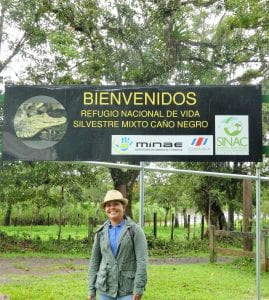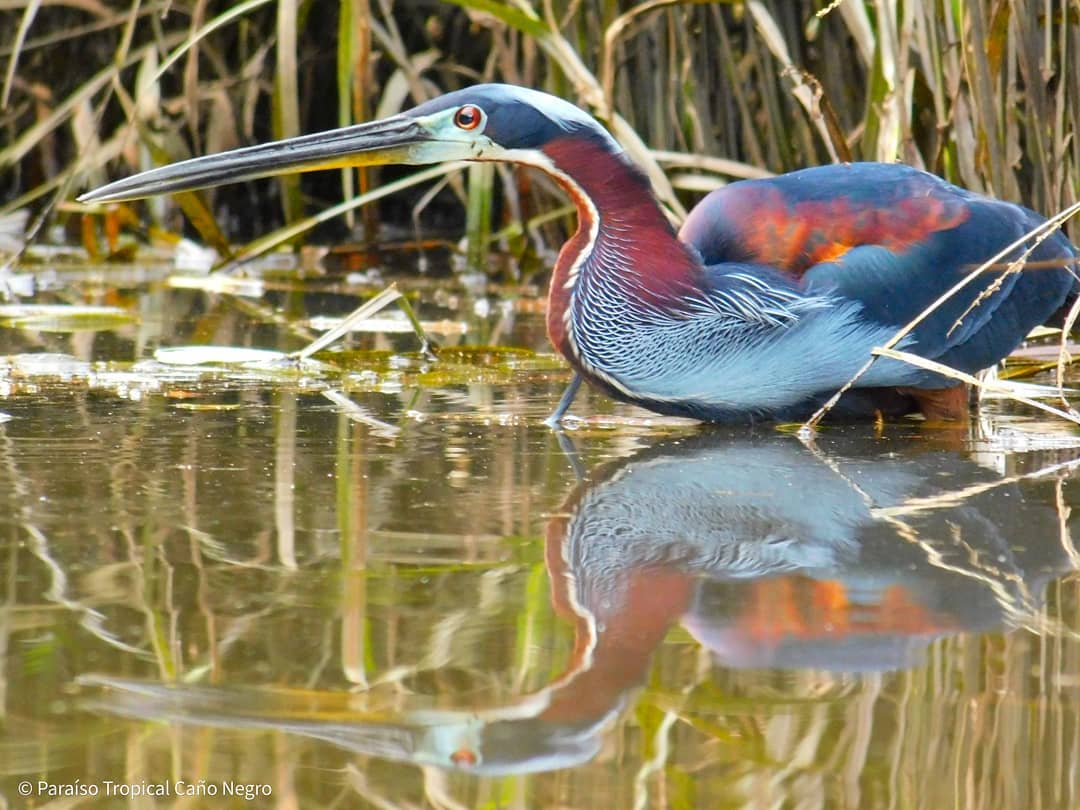Years ago, a day boat trip on the Rio Frio from La Fortuna to the Nicaraguan border introduced me to Caño Negro, a premiere bird-watching locale.
On that trip, one of my fellow passengers would shout, “Thirty-seven!” All but me would rush with their binoculars to that side of the vessel. “Fifty-two!” “Eighteen!” Each announced number nearly toppled the boat. Armed with The Birds of Costa Rica: A Field Guide, these avid bird watchers had devised some sort of numbering system and were determined to see as many of the 800 species of winged creatures as possible. They were not disappointed.
A recent excursion to Refugio Nacional de Vida Silvestre Mixto Caño Negro featured a second voyage on the Frio River, this time embarking inside the famous fresh water wetlands. My companions, although not avid bird watchers, were entranced by the nature that unfolded.
This time of year when Costa Rica is drenched in rain, many avoid going to beaches or rainforests. May to mid-November, though, is the perfect time of year to venture north to the nearly 10,000 hectare reserve of wetlands. Lake Caño overflows, attracting migrating birds. Lagoons that don’t exist are magically reborn. Umbrellas and ponchos are recommended.

See this article in the International Digital Magazine, click here.Experience in the audiovisual edition, click here.JTNDaWZyYW1lJTIwc3JjJTNEJTIyaHR0cHMlM0ElMkYlMkZ3d3cuZ29vZ2xlLmNvbSUyRm1hcHMlMkZlbWJlZCUzRnBiJTNEJTIxMW0xOCUyMTFtMTIlMjExbTMlMjExZDMxMzQzLjQ5NDIzNzk0MTA5MyUyMTJkLTg0LjgxMzE3OTYyOTc1NjQzJTIxM2QxMC44OTI0MDkzMDM1MzU5NjclMjEybTMlMjExZjAlMjEyZjAlMjEzZjAlMjEzbTIlMjExaTEwMjQlMjEyaTc2OCUyMTRmMTMuMSUyMTNtMyUyMTFtMiUyMTFzMHg4ZjBhYjdhMDZjZjg0NDIzJTI1M0EweDIyNGZkOTY4NjU2ODBkYjAlMjEyc0FsYWp1ZWxhJTI1MjBQcm92aW5jZSUyNTJDJTI1MjBDYSUyNUMzJTI1QjFvJTI1MjBOZWdybyUyNTIwRGlzdHJpY3QlMjE1ZTAlMjEzbTIlMjExc2VuJTIxMnNjciUyMTR2MTYyNjcyNTg4NjcwOSUyMTVtMiUyMTFzZW4lMjEyc2NyJTIyJTIwd2lkdGglM0QlMjI2MDAlMjIlMjBoZWlnaHQlM0QlMjI0NTAlMjIlMjBzdHlsZSUzRCUyMmJvcmRlciUzQTAlM0IlMjIlMjBhbGxvd2Z1bGxzY3JlZW4lM0QlMjIlMjIlMjBsb2FkaW5nJTNEJTIybGF6eSUyMiUzRSUzQyUyRmlmcmFtZSUzRQ==
Hours of Operation:
Every day from 8 a.m. to 4 p.m.
Telephone: +506 2471-1309
PHOTOS:
Tour guide Rosi Arguedas descends from Nicaraguan settlers in the Caño Negro several generations ago.
Sightings of the colorful agami heron are a highlight for birdwatchers on some Caño Negro excursions.Globally important wetlands
Our guide, Rosi Arguedas, who narrates the boat trip, lives on an island on the Caño Negro Wildlife Refuge. Her Nicaraguan grandparents arrived long before the wetlands were designated as one of the most important in the world.
Generations ago, Rosi’s family moved from Nicaragua to join the Huleros people who extracted latex from rubber trees. These settlers named the region Caño Negro because of the dark, yet transparent water in the canals.
Under Rosi’s guidance, as the boat winds its way through the waters, visitors slow their breathing. They drink in the scenery as a restful trip ensues, traversing the many canals, channels and, during this time of year, the gorged lagoons. Wide-eyed caimans emerge along the riverbank to seek smaller birds and other food.
Rosi points out a basilisk lizard, commonly called the Jesus Christ Lizard, just before he scampers across the water. She directs us to see the top of trees where aerial iguanas bask and sway. Here is an ibis, there a Nicaraguan grackle, and over there a yellow-breasted crake. She demonstrates her skills at imitating a monkey roar, a band of Howler monkeys responding to her with their characteristic throaty response.
“Do you smell that?” Rosi asks our group. We detect a musky odor, not quite as powerful as a skunk. “That is a male jaguar who has left his scent to mark his territory.”
Because jaguars attack cows on the farms near the wetlands, the program Pro Jaguar Caño Negro was formed by Rosi and others to educate farmers about jaguar movements and how to prevent attacks on cattle. Each ticket purchased on the boat tours donates $2 toward jaguar protection.
Rosi and her family live inside the reserve, along with a handful of other families. These few inhabitants cannot cut down any trees and must live in existing structures. No new building is permitted. They cannot use chemicals, hunt, or introduce any new species of plants or wild animals.
Aurora Romero Barrios, Rosi’s grandmother, contributed the land for the central park in the nearby village of Caño Negro.
Of her abuela, Rosi says, “She inspired me to work on what I like and, like her, leave a legacy for future generations. She dreamed of a park that families enjoy. I dream that future generations can enjoy the Caño Negro wetlands as I do.”
My memories of African safaris with a Masai escort and seeing the pampas of Argentina with a former gaucho are reminders of how important it is to have a local, knowledgeable captain at the helm. Rosi points us towards the agami heron, a bird whose plumage could vie with the quetzals. Her trained eyes locate what we cannot see. Her life experience inspires us to respect and help protect one of the most important ecosystems on our planet.JTNDaWZyYW1lJTIwc3JjJTNEJTIyaHR0cHMlM0ElMkYlMkZ3d3cuamlnc2F3cGxhbmV0LmNvbSUyRiUzRnJjJTNEcGxheSUyNmFtcCUzQnBpZCUzRDM2YTNjMzg0MDQ3YSUyNmFtcCUzQnZpZXclM0RpZnJhbWUlMjIlMjBzdHlsZSUzRCUyMndpZHRoJTNBMTAwJTI1JTNCaGVpZ2h0JTNBNjAwcHglMjIlMjBmcmFtZWJvcmRlciUzRDAlMjBhbGxvd2Z1bGxzY3JlZW4lM0UlM0MlMkZpZnJhbWUlM0U=






